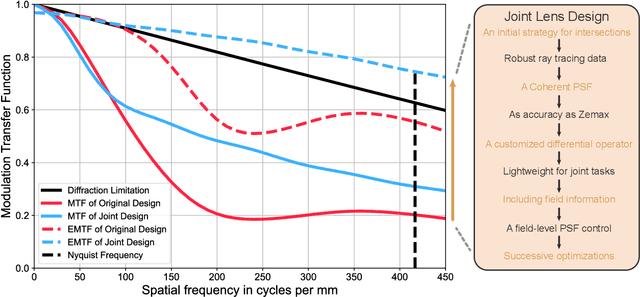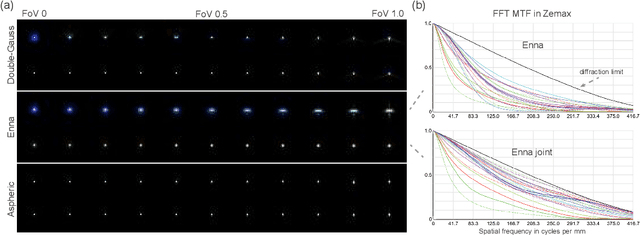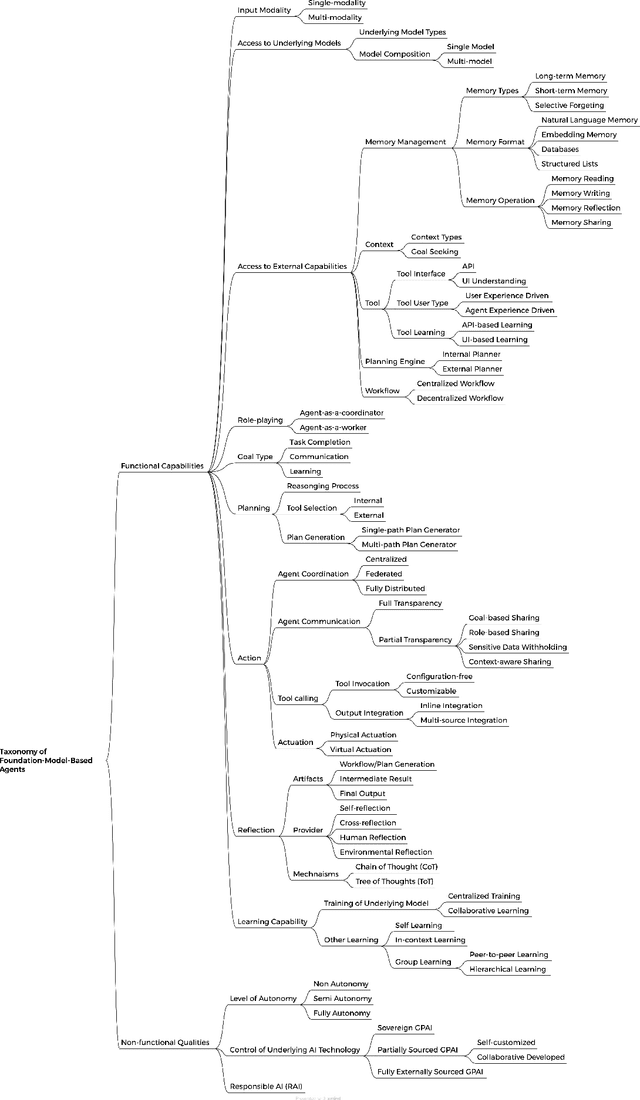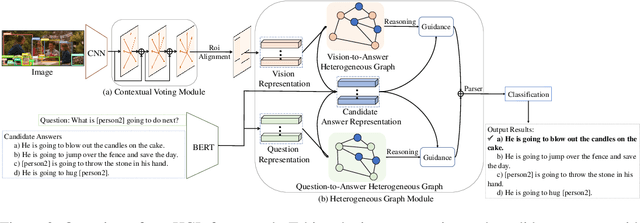Jingwen Zhou
Successive optimization of optics and post-processing with differentiable coherent PSF operator and field information
Dec 19, 2024



Abstract:Recently, the joint design of optical systems and downstream algorithms is showing significant potential. However, existing rays-described methods are limited to optimizing geometric degradation, making it difficult to fully represent the optical characteristics of complex, miniaturized lenses constrained by wavefront aberration or diffraction effects. In this work, we introduce a precise optical simulation model, and every operation in pipeline is differentiable. This model employs a novel initial value strategy to enhance the reliability of intersection calculation on high aspherics. Moreover, it utilizes a differential operator to reduce memory consumption during coherent point spread function calculations. To efficiently address various degradation, we design a joint optimization procedure that leverages field information. Guided by a general restoration network, the proposed method not only enhances the image quality, but also successively improves the optical performance across multiple lenses that are already in professional level. This joint optimization pipeline offers innovative insights into the practical design of sophisticated optical systems and post-processing algorithms. The source code will be made publicly available at https://github.com/Zrr-ZJU/Successive-optimization
A Taxonomy of Architecture Options for Foundation Model-based Agents: Analysis and Decision Model
Aug 06, 2024


Abstract:The rapid advancement of AI technology has led to widespread applications of agent systems across various domains. However, the need for detailed architecture design poses significant challenges in designing and operating these systems. This paper introduces a taxonomy focused on the architectures of foundation-model-based agents, addressing critical aspects such as functional capabilities and non-functional qualities. We also discuss the operations involved in both design-time and run-time phases, providing a comprehensive view of architectural design and operational characteristics. By unifying and detailing these classifications, our taxonomy aims to improve the design of foundation-model-based agents. Additionally, the paper establishes a decision model that guides critical design and runtime decisions, offering a structured approach to enhance the development of foundation-model-based agents. Our contributions include providing a structured architecture design option and guiding the development process of foundation-model-based agents, thereby addressing current fragmentation in the field.
Revealing the preference for correcting separated aberrations in joint optic-image design
Sep 12, 2023Abstract:The joint design of the optical system and the downstream algorithm is a challenging and promising task. Due to the demand for balancing the global optimal of imaging systems and the computational cost of physical simulation, existing methods cannot achieve efficient joint design of complex systems such as smartphones and drones. In this work, starting from the perspective of the optical design, we characterize the optics with separated aberrations. Additionally, to bridge the hardware and software without gradients, an image simulation system is presented to reproduce the genuine imaging procedure of lenses with large field-of-views. As for aberration correction, we propose a network to perceive and correct the spatially varying aberrations and validate its superiority over state-of-the-art methods. Comprehensive experiments reveal that the preference for correcting separated aberrations in joint design is as follows: longitudinal chromatic aberration, lateral chromatic aberration, spherical aberration, field curvature, and coma, with astigmatism coming last. Drawing from the preference, a 10% reduction in the total track length of the consumer-level mobile phone lens module is accomplished. Moreover, this procedure spares more space for manufacturing deviations, realizing extreme-quality enhancement of computational photography. The optimization paradigm provides innovative insight into the practical joint design of sophisticated optical systems and post-processing algorithms.
Heterogeneous Graph Learning for Visual Commonsense Reasoning
Oct 25, 2019



Abstract:Visual commonsense reasoning task aims at leading the research field into solving cognition-level reasoning with the ability of predicting correct answers and meanwhile providing convincing reasoning paths, resulting in three sub-tasks i.e., Q->A, QA->R and Q->AR. It poses great challenges over the proper semantic alignment between vision and linguistic domains and knowledge reasoning to generate persuasive reasoning paths. Existing works either resort to a powerful end-to-end network that cannot produce interpretable reasoning paths or solely explore intra-relationship of visual objects (homogeneous graph) while ignoring the cross-domain semantic alignment among visual concepts and linguistic words. In this paper, we propose a new Heterogeneous Graph Learning (HGL) framework for seamlessly integrating the intra-graph and inter-graph reasoning in order to bridge vision and language domain. Our HGL consists of a primal vision-to-answer heterogeneous graph (VAHG) module and a dual question-to-answer heterogeneous graph (QAHG) module to interactively refine reasoning paths for semantic agreement. Moreover, our HGL integrates a contextual voting module to exploit a long-range visual context for better global reasoning. Experiments on the large-scale Visual Commonsense Reasoning benchmark demonstrate the superior performance of our proposed modules on three tasks (improving 5% accuracy on Q->A, 3.5% on QA->R, 5.8% on Q->AR)
 Add to Chrome
Add to Chrome Add to Firefox
Add to Firefox Add to Edge
Add to Edge